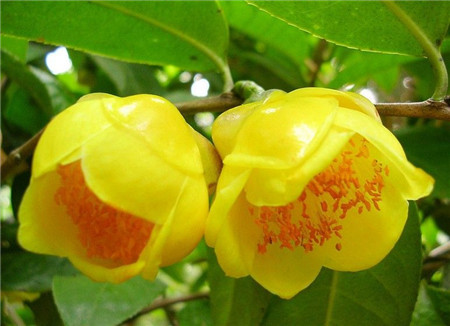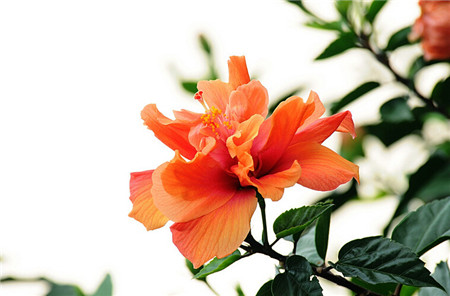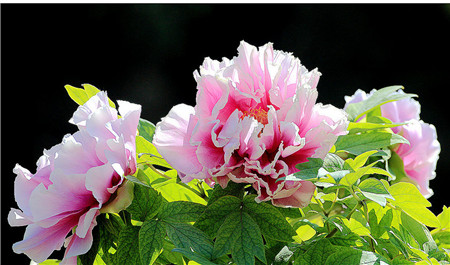Cultivation methods of Camellia
Camellia is a common flower in daily life. The cultivation methods of camellia are divided into ground-planted camellias and potted camellias, among which potted camellias are divided into garden cultivation and nursery cultivation.
The cultivation method of Camellia planting Camellia in the Land
It can be divided into garden cultivation and nursery cultivation. For example, for landscaping cultivation, shade trees should be used as companions, and shade trees should be planted in rows in nursery cultivation. In warm areas, autumn planting is better than spring planting. Three key periods of fertilization should be mastered: topdressing from February to March to promote the growth of spring shoots and buds, topdressing in June to promote "secondary branch growth and improve drought resistance", and base fertilizer from October to November to improve plant cold resistance. to lay a good foundation for the growth of new shoots in the following spring. Cleaning the garden is one of the effective measures to control diseases and insect pests and enhance the tree potential. Winter ploughing can eliminate overwintering pests. Intertillage and weeding should be carried out for 5 or 6 times in the whole year, but intertillage should be stopped in summer high temperature season to reduce soil water evaporation. The main insect pests of camellia are: tea caterpillar, tea moth, tea aphid and so on. The main diseases are: tea ring spot, camellia algae spot, camellia anthracnose and so on. The method of control is to remove the dead branches and leaves and eliminate the source of infection. Strengthen cultivation management to enhance plant disease resistance and drug control.
The cultivation method of Camellia: potted Camellia
The proportion of basin size to seedlings should be appropriate. The basin soil had better be added to the garden soil to cut off pine needles which have been rotten for one year. Put it on the basin in November or February-March of the following year, and avoid it in the high temperature season. After putting on the basin, the water should be well watered, and the right amount of water should be watered at ordinary times. The amount of water should change with the season, and the amount of water should increase gradually when the plant enters the growth and germination period before and after Qingming Festival. After the new shoot stops growing (about late May), watering should be properly controlled to promote flower bud differentiation. June is the rainy season, so we should guard against stagnant water. Summer high temperature season foliar evaporation, the need for foliar spray, water spraying should be carried out in the early morning or evening, do not spray water at noon. In winter, the plant gradually enters the human body to sleep, and the watering times should be reduced accordingly. Do not pour cold water in the hot sun, so as not to cause root maladjustment, resulting in physiological leaf loss. When the temperature is high or the wind is strong, the leaf evaporation is large, so you should water or spray more water. When the air humidity is high, the amount of water should be reduced. In case of drought and dehydration, branches and leaves wilt, plant and plant should be placed in the shade immediately, water should be watered thoroughly, and foliar spray should be carried out at the same time. Large leaves, large flowers and fast-growing varieties of camellias require a lot of water and should be watered more. Valuable varieties such as: + Xiangjing, mandarin Phoenix crown, wine Jinbaozhu, impatiens, green beads and other water evaporation is less, too much watering will cause fallen leaves and buds. Shading and cooling should be carried out in time in summer and autumn high temperature season. Anti-freezing measures should be taken in winter. Pot plants winter indoors, it is appropriate to maintain 3-4 degrees Celsius, if the temperature exceeds 16 degrees Celsius, it will promote early germination. The fertilization, pruning and pest control of potted camellias are basically the same as those of open field cultivation.

Key points of cultivation of Camellia in Winter
Camellia is cherished by the horticultural circles all over the world because of its beautiful plants, bright green leaves and colorful flowers. However, winter is not such an easy season for camellias, as camellias are more expensive, so winter maintenance must not be taken lightly.
Camellia (details)
First, lighting: Camellia should be placed in a sunny place indoors in winter. If the light is too weak, camellia will grow poorly and are prone to diseases and insect pests.
Second, temperature: Camellia likes to be warm and cold, the indoor temperature should not be lower than 5 ℃, and the best temperature should be kept at 10 ℃ ~ 15 ℃.
Third, humidity: generally dry indoor in winter, should often spray water to the camellia page, in order to form a humid microclimate, but avoid spraying water in cloudy and rainy weather.
Fourth, watering: winter camellia watering depends on the situation, generally watering once every three days, keep the basin soil moist, avoid stagnant water or half of the water. Tap water should be kept for a day or two and used after chlorine in the water is volatilized. 1% of ferrous sulfate can be dissolved in the water to improve the water quality.
Fifth, fertilization: Camellia like fertilizer, autumn and winter flower buds develop rapidly, should be irrigated once a week Xiaomei flower type, too much nitrogen fertilizer buds easy to scorch, should be applied less or not after flowering.
Cultivation techniques of Camellia
General situation
Camellia, also known as Camellia, belongs to the genus Camellia of Theaceae. Camellia flower is one of the top ten famous flowers in China because of its rich appearance and dignified elegance. It is also one of the world's famous flowers.
Camellia is native to China. In the early 7th century, Japan introduced camellias from China to a large number of camellias in China at the beginning of the 15th century. Camellia was first introduced to Britain in 1739, and then it was introduced into Europe and the United States. So far, the United States, Britain, Japan, Australia and Italy and other countries have developed rapidly in the breeding, reproduction and production of camellia, and have entered the stage of industrial production, and intervarietal, interspecific hybrids and new varieties have been listed continuously.
The cultivation of camellia in China has a long history. Camellia has been cultivated since the Southern Dynasty. Camellia was cultivated as a precious flower in the Tang Dynasty. In the Song Dynasty, the cultivation of camellia was very popular. In the Southern Song Dynasty, camellias from Wenzhou were introduced to Hangzhou and developed rapidly. The varieties of camellia are described and classified in the History of Flowers in the Ming Dynasty. In the Qing Dynasty, cultivated camellias became more popular, and camellia varieties appeared continuously. Since 1949, the cultivation level of camellia in China has been improved to a certain extent, and the breeding of camellia varieties has been developed. At present, there are more than 300 varieties of camellia in China. Mass production has been started in Zhejiang, Fujian and Jiangsu. At present, it has become the main pot ornamental flowers and trees in the flower market in winter.
Morphological characteristics and varieties
Camellia is an evergreen broad-leaved shrub. Leaves alternate, leathery, elliptic, margin serrate, dark green. Flowers solitary or 2-3 on top of branches or in axils of leaves. Single or semidouble flowers. Double. Common varieties are single-petal dawn, frilled flowers, pure white; golden light, white flowers, pink lines and fine spots; large golden heart, bright red flowers, flower diameter 6-7 cm; semidouble Sailuoyang, flower red, with white spots; big pine nuts, crimson flowers; drunken concubine, pollen red; star peony, peach red. Double white beads, pure white flowers; red hibiscus, bamboo peach; hibiscus, flowers white, with red lines; flowers, pollen red, with irregular red stripes; Wuhe holding the ball, bright red flowers; Hua Fuding, flowers bright red, with a small amount of white spots; eight bachelors, flowers red; red flowers, red flowers; flower Heling, flowers light red, with white spots.
Biological characteristics
Camellia is native to China. Like warm, moist and semi-overcast environment. Afraid of the high temperature, avoid the scorching sun.
The optimum temperature for the growth of camellia is 18-25 ℃, 13-18 ℃ from March to September, and 10-13 ℃ from September to March of the following year. When the temperature is above 12 ℃, it starts to sprout, and when it is over 30 ℃, it stops growing. The initial temperature of flowers is 2 ℃, and the suitable temperature for flowers to open is 10-20 ℃. The cold-tolerant varieties of camellia can tolerate-10 ℃ for a short time, and the general variety-3murmur4 ℃. Leaf burns occur when the summer temperature exceeds 35 ℃. Camellia is suitable for sufficient water, humid air environment, avoid drying. In summer and autumn with high temperature and drought, water should be watered or sprayed in time, and the air relative humidity should be 70% and 80%. Pay attention to drainage during the rainy season so as not to cause waterlogging and rot on the roots.
Camellia is a semi-negative plant, suitable for growing under scattered light, afraid of direct light exposure, seedlings need shade. However, long-term overshade is disadvantageous to the growth of camellia, thin leaves and less flowering, affecting the ornamental value. Adult plants need more light to facilitate flower bud formation and flowering.
When cultivated in open field, the soil layer is deep, loose, good drainage, pH 5-6 is the most suitable, alkaline soil is not suitable for camellia growth. Potted soil uses fertile, loose, slightly acidic loam or rotten leaf soil.
Breeding method
Cutting, grafting, striping, sowing and tissue culture are commonly used.
Cutting propagation: the most suitable is about the middle of June and the end of August. The semi-mature branches of the same year with full external tissue, complete leaves and full leaf buds were selected as cuttings, with a length of 8-10 cm and 2 leaves at the apex. When cutting, the base takes a little old branch as far as possible, it is easy to form callus after insertion, and the root is fast. Cuttings cut early in the morning, to cut along with the cutting, insert the substrate of about 3 cm, cuttings require leaves to hand over each other, after cutting with fingers. It is better to insert it shallowly, so that it can heal and take root quickly. The inserting bed should be shaded, spray the leaf surface every day, keep it moist, maintain the temperature at 20-25 ℃, begin to heal about 3 weeks after insertion, and take root after 6 weeks. Transplant into a pot when the root is 3-4 cm long. When cutting, 0.4% Mel 0.5% indolebutyric acid solution was dipped in the base of the cuttings for 2-5 seconds, which could obviously promote rooting.
Grafting propagation: often used in varieties where it is difficult for cuttings to take root or have few propagation materials. The survival rate of grafting was the highest when the new shoots were semi-qualitative from May to June, and the shoots sprouted quickly after grafting. The rootstocks are mainly Camellia oleifera, which are collected in October, stored in winter and sown in early April of the following year. When the seedlings grow to 4-5 cm, they can be used for grafting. Using the method of tender branch splitting, cut off the germ of the bud rootstock with a blade, cut it longitudinally along the pith in the center of the cross section of the Hypocotyl, then take a section of the scion of Camellia, and cut the base under the node into a positive wedge, immediately insert the cut scion into the bottom of the crack of the rootstock, aim at the cambium on both sides, bind it with cotton thread, and cover it with a clean plastic pocket. Remove the pocket after about 40 days, and sprout in about 60 days.
Striping propagation: in the rainy season, a robust 1-year-old branch is selected, 20 cm away from the top, peeled in a ring shape, 1 cm wide, bound with rotten leaf soil and covered with plastic film, rooting after about 60 days, cut off can be directly potted, the survival rate is high.
Sowing and propagation: suitable for single or semi-double varieties. The seeds are ready for sowing when they mature in the middle of October. Shallow sowing is better, vermiculite as substrate, covering 6 mm, room temperature 21 ℃, light for 10 hours per night, can promote seed germination, germination begins 15 days after sowing, seedling height reaches 8 cm within 30 days, seedlings are transplanted when they have 2-3 leaves.
Tissue culture and propagation: the common seedlings of explants were cut into 1cm long after routine disinfection and inoculated on MS medium supplemented with kinetin 1mg / L, 6-benzylaminoadenine 1mg / L and indole acetic acid 0.1mg / L. After 4 weeks of culture, only calli were formed, but not buds. After transferred to the new medium, a single branch of 4cm was formed, then soaked in 0.5mg / L indolebutyric acid solution for 20 minutes, then transferred to 1/2MS medium, and roots grew after 4 weeks. After growing on long root medium for 8 weeks, the seedlings were transplanted to a basin filled with perlite and peat.
Cultivation and management
Camellia flower pots are often planted in 15-20 cm pots. Camellia root system is fragile, transplanting should be careful not to hurt the root system. Potted camellia, change pots every spring after flowering or September-October, cut off long or withered branches and replace them with fertile rotten leaf soil. Camellia likes to be moist, but the soil should not be too wet, especially potted plants, which can easily cause rotten roots. On the contrary, impermeable irrigation, too dry, leaves curling, will also affect the development of flower buds.
After changing the pot of camellia in spring, there is no need to apply fertilizer immediately. During the vigorous growth period of stems and leaves after the beginning of summer, fertilize once a month or use "Huiyou" 21 Mel 7 Mel 7 acid fertilizer. From budding to flowering in September, the phosphorus and potassium fertilizer was applied 1-2 times. Camellia begins to form flower buds in late summer and early autumn. 1-2 buds should be left on each shoot, not too many, so as not to consume nutrients and affect the flowering of the main buds. Pay attention to the position of leaf buds when picking buds in order to keep the plant shape beautiful. At the same time, the dry waste buds are easily removed.
Pest control
When camellia is cultivated indoors or in greenhouse, if it is not well ventilated and is vulnerable to red spiders and shell insects, it can be sprayed or washed clean with 1000 times omethoate EC. The air humidity is high during the plum rain season, and anthracnose often occurs. It can be sprayed with the same amount of Bordeaux liquid or 1000 times of carbendazim wettable powder.
Postpartum treatment
Camellia has a beautiful crown, bright green leaves, large and colorful flowers, and a long flowering period, coinciding with New Year's Day and the Spring Festival. Potted plants decorate the guest room, study and balcony, showing an elegant and luxurious atmosphere. Planted in the courtyard, accompanied by flower walls and mountains and rocks in front of the pavilion, the scenery is natural and pleasant. In the process of storage and transportation, it is necessary to prevent high temperature and air drying, otherwise buds and flowers are easy to fall off and affect the quality.
For more information:
The identification and control of flower pests how to promote the rooting of flowers? Peony blossoms in greenhouse in winter
- Prev

How do the mulberry flowers be grafted?
The Fusang flower is the state flower of Hawaii and the national flower of Malaysia. Its design and color is rich, gorgeous and noble. Now many people take it for grafting, realizing that there are different colors of Fusang flowers on the Fusang tree, which greatly improves its ornamental value. So how do Fusang flowers be grafted?
- Next

How to plant peonies?
Although the peony is good-looking, it is not easy to grow. How to plant the peony? Today, Flower Encyclopedia will answer for you how to plant peonies. 1. Choose sunny, non-stagnant land, preferably a sunrise slope, sandy loam with fertile soil and good drainage. Turn the soil deeply before planting, and the planting pit should be appropriately large.
Related
- Fuxing push coffee new agricultural production and marketing class: lack of small-scale processing plants
- Jujube rice field leisure farm deep ploughing Yilan for five years to create a space for organic food and play
- Nongyu Farm-A trial of organic papaya for brave women with advanced technology
- Four points for attention in the prevention and control of diseases and insect pests of edible fungi
- How to add nutrient solution to Edible Fungi
- Is there any good way to control edible fungus mites?
- Open Inoculation Technology of Edible Fungi
- Is there any clever way to use fertilizer for edible fungus in winter?
- What agents are used to kill the pathogens of edible fungi in the mushroom shed?
- Rapid drying of Edible Fungi

